Q.8 Explain various types of interactions in an ecosystem.
In all ecosystems, there are many kinds of interaction among living organisms.
(i) Intraspecific interactions
The interactions between the members of the same species are called intraspecific interactions
(ii) Interspecific interactions
The interactions between the members of different species are called interspecific interactions. Some important interactions among living organisms in ecosystem are given below:
1. Competition
2. Predation.
3. Symbiosis
1) Competition
In ecosystems, the natural resources e.g. nutrients, space etc. are usually in short supply. So, there is competition among the organisms of ecosystem for the utilization of resources. The competition may be intraspecific or interspecific.
Intraspecific competition is always stronger and more severe than the interspecific competition. Competition helps in maintaining a balance between the available resources and the number of individuals of a species.
2) Predation
Definition
It is an interaction between two animals of different species or between a plant and an animal. In predation, one organism (the predator) attacks, kills and feeds on other organism (the prey). All carnivore animals are predators. Some examples of predation are given below:
Examples
1. Frog preys upon mosquito and fox preys upon rabbit. There are some examples where a predator is preyed upon by a second predator and then the second one is preyed upon by a third predator. For example, frog (predator 1) is preyed upon by a snake (predator 2) and the snake is preyed upon by an eagle (Predator 3).
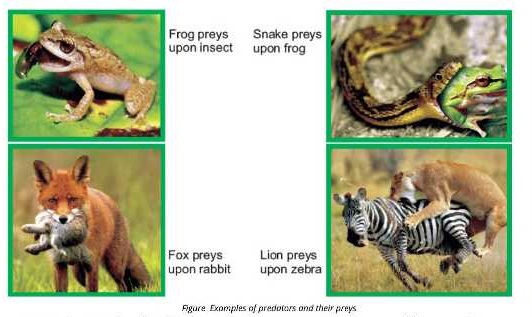
2. Certain plants (Pitcher plant, Sundew, Venus fly trap etc.) are carnivorous and live as predators. Such plants live in the areas where minerals and other nutrients are lacking. They feed on insects to fulfill their nitrogen requirements. These plants have mechanism to attract insects. For example, they secrete sweet nectar that attracts the insects searching for food. Their leaves are also modified to capture the prey.
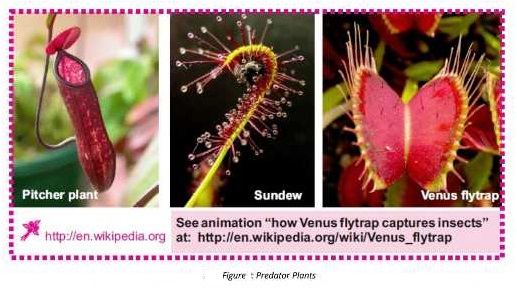
Importance of predation
Predation keeps the prey population under check, so as to maintain an ecological balance. Humans benefit from this interaction in the biological control of weeds and pests. In order to control pests in an area, their predators are released there.
3) Symbiosis
Definition
It is a relationship between members of different species, in which they live together for longer or shorter periods of time.
Example
Lichens (Association between algae and fungi)
Types of symbiosis
A. Parasitism
Definition
It is a type of symbiosis in which smaller partner (parasite) derives food and shelter from the body of larger partner (host) and, in turn, harms it.
Host
The organism on which a parasite feeds is called host.
Parasite
Parasite is an organism that gets shelter and food from its host and in return harms it. Host can survive without parasite, but parasite cannot survive without host.
Types of Parasites
a) Ectoparasites
Ectoparasites live outside i.e. on the surface of host’s body and get food from there.
Examples
Mosquitoes, leeches, lice etc.
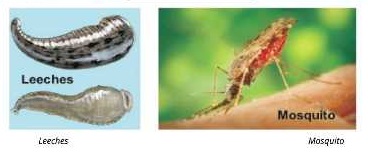
b) Endoparasitesi
Endoparasites live inside the body of host and get food and shelter from there.
Examples
Bacteria, viruses, tapeworm, Ascaris, Entamoeba, Plasmodium etc.
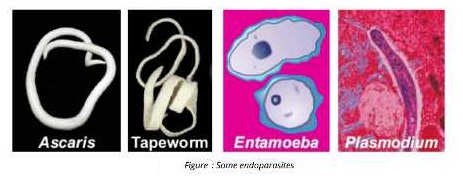
Parasitic Plants
Some plants (e.g. Cuscuta, also called dodder) are parasites on other plants. Parasitic plants grow special types of roots (haustoria) into host body and suck the required nutrients from the vascular tissues of host.
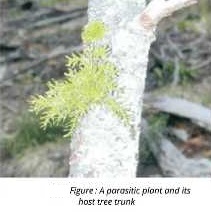
Types of Parasitism
a) Temporary Parasitism
In temporary parasitism, the parasite spends most of its life cycle as independent free- living organisms. Only a part of its life cycle is spent as a parasite. Leech, bed bug, mosquito are common temporary parasites of humans.
b) Permanent Parasitism
In permanent parasitism, the parasites spend their whole life cycles as parasites. Many disease causing bacteria and all viruses are permanent parasites.
B) Mutualism
The type of symbiosis in which both partner get benefit from each other and neither is harmed.
Examples
(i) Termites eat wood but are unable to digest it. A protozoan called zooflagellate lives in its intestine. It secretes ‘cellulase’ enzyme to digest the cellulose of wood. In turn, the termite provides food and shelter to the protozoan.
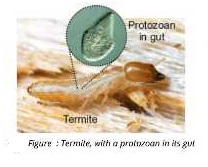
(ii) The nitrogen fixer bacteria Rhizobium live in the root nodules of leguminous plants like pea, gram etc. The bacteria obtain food and shelter from plants while in return they fix gaseous nitrogen into nitrates for the plant which is required for their growth.
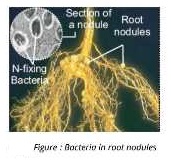
C) Commensalism
It is a type of symbiosis in which one partner is benefited while the other is neither benefited nor harmed.
Examples
i. Epiphytes are small plants found growing on other larger plants for space only. They absorb
water and minerals from the atmosphere and prepare their own food. The larger plants are
neither benefited nor harmed in any way.
ii. Sucker fish attaches to the surface of sharks by its sucker. In this way, the shark provides easy
transport to the sucker fish to new feeding grounds.
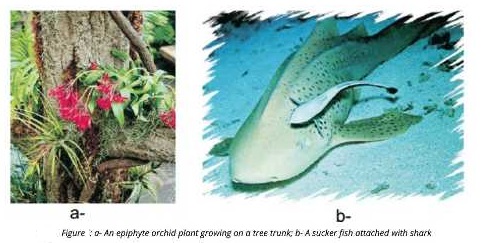
iii. An example of commensalism (Honey Guide bird and Badger)
The honey guide bird feeds on wax and the larvae present in honeycombs. It flies around looking for honeycombs, but it is not strong enough to open the comb. Badgers are large mammals that feed on honey. When a honey guide bird goes to find honeycombs, the badger follows it. When the bird find a honeycomb, it calls the badger. Sometimes the bird has to stop and wait for the slow moving badger. After reaching there, the badger open the honeycomb and both of them eat their foods together. Traditionally, humans have also used these birds to find honeybee colonies.
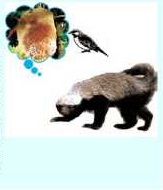 \
\
![]()